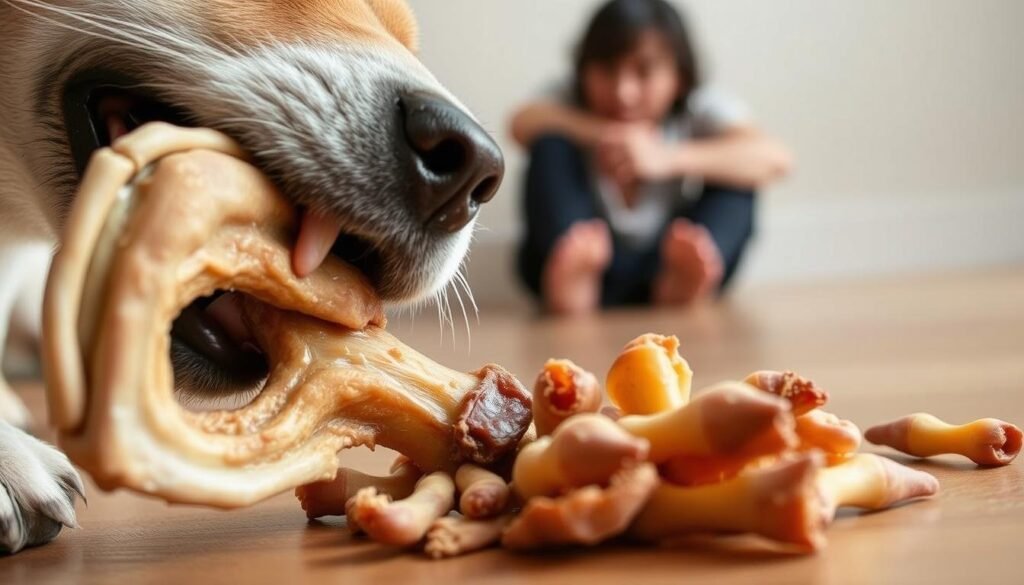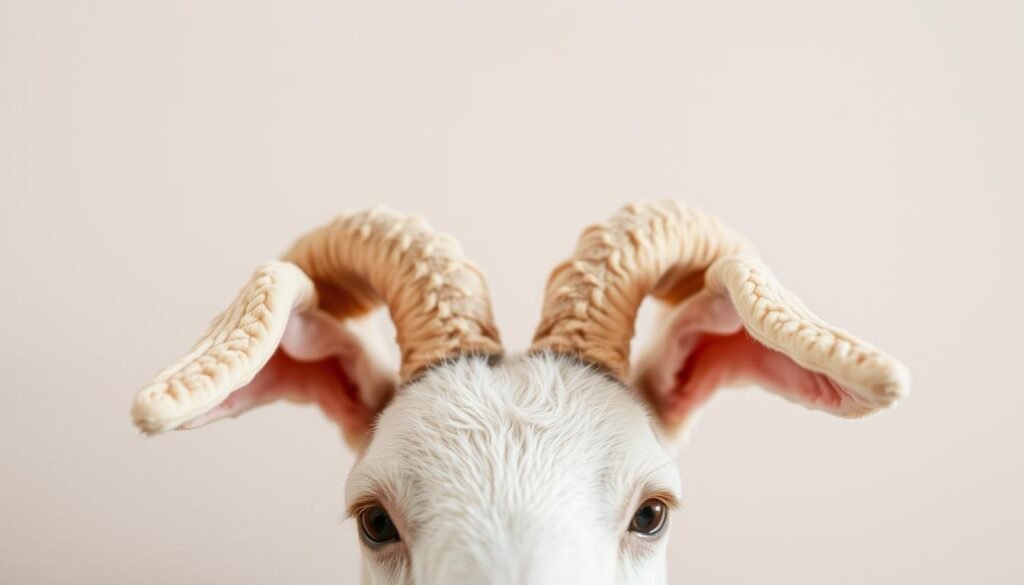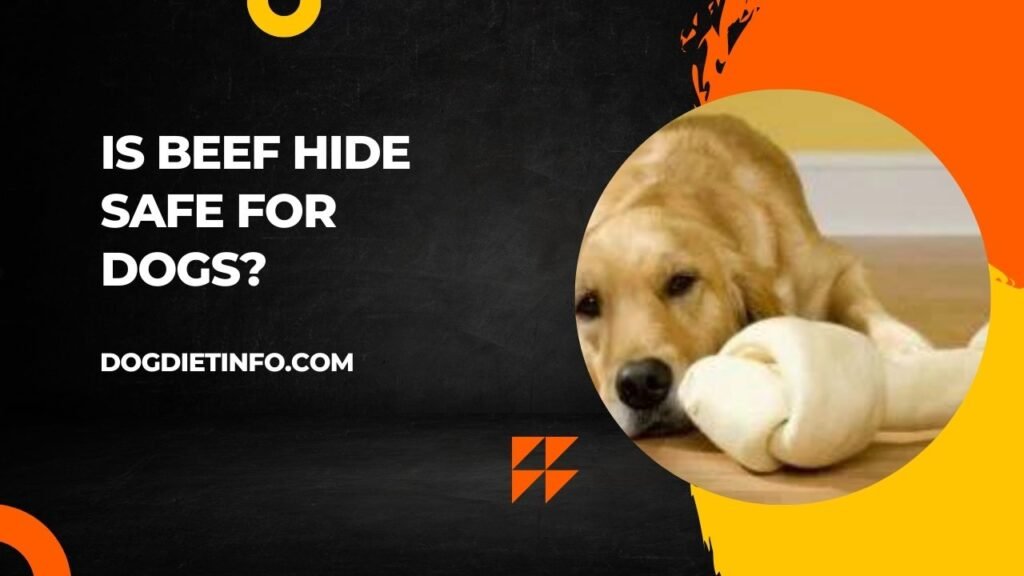If you own a dog, you’re always searching for the best treats. Lamb ears have become popular as a chew for dogs. But, are they safe for your pet?
Lamb ears are a new protein source for dogs. They’re good for dogs with food allergies because they’re low in fat and high in protein. This makes them a healthy snack.
Before giving your dog lamb ears, you need to think about a few things. You should know where they come from, how they’re processed, and any risks they might have.
Contents
- 1 What Are Lamb Ears and Their Nutritional Value
- 2 Are Lamb Ears Safe Chews for Dogs?
- 3 Benefits of Lamb Ears as Dog Chews
- 4 Potential Risks and Precautions
- 5 How to Properly Offer Lamb Ears to Your Dog
- 6 Lamb Ears: A Safe and Nutritious Choice for Your Dog
- 7 FAQ
- 7.1 Are lamb ears a nutritious chew option for my dog?
- 7.2 How do lamb ears support my dog’s dental health?
- 7.3 Can lamb ears be a choking hazard for my dog?
- 7.4 How should I introduce lamb ears to my dog’s diet?
- 7.5 Can I give lamb ears to my puppy?
- 7.6 Are there any potential allergic reactions to lamb ears I should be aware of?
- 7.7 How do I store lamb ears to maintain their freshness?
What Are Lamb Ears and Their Nutritional Value
Lamb ears are a great choice for dog owners looking for healthy chews. They are the ears of lambs, dried or cooked to keep them as treats. These treats are full of protein, have some fat, and are packed with vitamins and minerals good for dogs.
Lamb ears are a great source of protein. This is key for your dog’s health, helping with muscle strength and repair. They also have important vitamins and minerals like:
- Vitamin A: Important for vision, immune function, and skin health.
- Zinc: Plays a critical role in numerous aspects of cellular metabolism.
- Iron: Essential for the formation of hemoglobin, which transports oxygen in the blood.
Lamb ears are not just high in protein. They also have fewer calories than many other dog chews. This makes them a healthy and guilt-free snack for your dog. It’s important to pick lamb ears from trusted suppliers to ensure they are safe and of good quality.
In short, lamb ears are a nutritious chew for dogs. They provide important protein, vitamins, and minerals. Adding lamb ears to your dog’s treats can help keep them healthy and happy.
Are Lamb Ears Safe Chews for Dogs?
Lamb ears are a favorite chew for dogs but come with safety concerns. They can be a nutritious and tasty treat. However, there are risks to consider.
One major concern is choking. Lamb ears can break into small pieces, posing a choking risk. It’s important to watch your dog closely while they chew. Choose ears that fit your dog’s size.
Another issue is digestive problems. Some dogs may get upset stomachs after eating lamb ears, especially if they’re sensitive or allergic. If your dog has digestive issues, start with small amounts to see how they react.
There’s also a risk of contamination. Lamb ears can carry bacteria like Salmonella or E. coli. This can harm your dog and your family. Make sure to buy from trusted suppliers and handle them clean.
In summary, lamb ears can be safe for dogs if done right. Knowing the risks helps keep them a fun and healthy treat for your pet.
Benefits of Lamb Ears as Dog Chews
Lamb ears are great for your dog’s health. They are a natural, protein-rich treat. They also help keep your dog’s teeth and gums healthy.
One big plus of lamb ears is they help keep your dog’s gums and teeth healthy. Chewing on them can cut down tartar and plaque. These are big causes of dental problems.
How Lamb Ears Support Dental Health
Chewing on lamb ears helps remove plaque and tartar from your dog’s teeth. This makes their gums healthier and their breath fresher. Here’s how lamb ears help dental health:
- Reduces tartar and plaque buildup
- Promotes healthy gums
- Supports overall dental health
Adding lamb ears to your dog’s chew routine can make their smile healthier and happier. Always watch your dog when they try new chews. Make sure the lamb ears fit your dog right to avoid any risks.
Potential Risks and Precautions
As a dog owner, knowing the risks of lamb ears is crucial. They can be a tasty and healthy snack. But, there are dangers to watch out for.
One big risk is an allergic reaction. Some dogs might be allergic to lamb or other ingredients in lamb ears. Watch your dog closely after they eat lamb ears. If they show signs of an allergy, like itching or swelling, see a vet.

Lamb ears can also be a choking hazard. This happens if they’re not chewed right or if they break into small pieces. Make sure to watch your dog while they eat lamb ears. Choose the right size for your dog.
To stay safe, follow some important steps. Always check lamb ears for spoilage before giving them to your dog. Keep them fresh by storing them right. Don’t overfeed, as this can upset your dog’s stomach.
Watching your dog closely is key when they eat lamb ears. Make sure they chew them right and don’t swallow big pieces. If your dog has swallowed things before or has other health issues, talk to your vet.
How to Properly Offer Lamb Ears to Your Dog
Introducing lamb ears to your dog needs careful steps for a safe and fun experience. Lamb ears can be a great treat, but they must be introduced slowly to avoid any bad reactions.
First, pick lamb ears that fit your dog’s size. Large lamb ears can be dangerous for small dogs. Small ones might not be enough for big dogs. Always choose the right size for your dog.
After introducing lamb ears, watch your dog closely. Look for signs like diarrhea, vomiting, itching, or swelling. These could mean they’re not doing well.
- Check for any changes in appetite or energy levels.
- Monitor stool quality and watch for signs of gastrointestinal distress.
- If you notice any adverse reactions, discontinue use and consult your veterinarian.
Remember to give lamb ears in small amounts at first. This helps you see how your dog reacts. If they do well, you can give more later.
By following these steps and watching your dog, you can add lamb ears to their treats safely. It’s a healthy and tasty snack for them.
Lamb Ears: A Safe and Nutritious Choice for Your Dog
As a dog owner, you want the best for your pet. Choosing the right chews is key to their health and wellbeing. Lamb ears are a nutritious and safe choice if introduced and managed right. They are full of protein and easy to digest, great for dogs with sensitive stomachs.
Knowing the benefits and risks of lamb ears helps you make better choices for your dog’s diet and chewing habits. With the right precautions, lamb ears can be a great addition to your dog’s treats. They help keep their teeth healthy and satisfy their natural chewing urge.
When picking lamb ears for your dog, look at the source, processing, and storage. This ensures you get a high-quality product. This way, you can give your dog a safe and fun chewing experience.
FAQ
Are lamb ears a nutritious chew option for my dog?
Yes, lamb ears are a great choice for dogs. They are full of protein, vitamins, and minerals. They can be a healthy part of your dog’s diet if given in the right amount.
How do lamb ears support my dog’s dental health?
Chewing on lamb ears can help clean your dog’s teeth. It can reduce tartar and plaque. This helps keep their gums and teeth healthy.
Can lamb ears be a choking hazard for my dog?
Yes, lamb ears can be a choking hazard. This is true if they’re too big for your dog or if your dog chews too aggressively. Always watch your dog while they chew and pick the right size.
How should I introduce lamb ears to my dog’s diet?
Start with a small amount of lamb ears when introducing them. Watch for any signs of upset stomach or allergies. Slowly add more as your dog gets used to them.
Can I give lamb ears to my puppy?
Yes, but make sure the lamb ears fit your puppy’s size. This prevents choking. Always watch your puppy while they chew to keep them safe.
Are there any potential allergic reactions to lamb ears I should be aware of?
Yes, some dogs might be allergic to lamb or have trouble digesting the high protein. Watch for signs like itching, swelling, or upset stomach. If you see any, talk to your vet.
How do I store lamb ears to maintain their freshness?
Keep lamb ears fresh by storing them in an airtight container. You can keep them in the fridge or freezer. This keeps them fresh for your dog to enjoy.

Derrick Wilcox is a certified canine behaviorist with over 12 years of experience at Happy Paws Animal Clinic and Pawsitive Training Center, helping pet owners ensure safer, healthier, and happier lives for their dogs.



